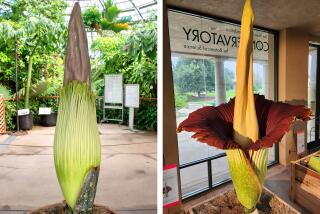No Room for Common Garden Varieties : Rare or Weird Is the Minimum Requirement in This Collection
- Share via
If a plant isn’t rare or weird, nurseryman Manny Singer probably doesn’t carry it. To get into Singer’s Northridge growing grounds, a plant should be shaped like a church steeple or a golf ball or at the least give off a strange odor.
Over the past two decades, Singer has carved out a tiny niche in the minuscule world of succulent fanciers.
His three-fourths acre nursery is chock full of rare succulent plants that are virtually unknown to mainstream gardeners.
Though his plants are no threat to rival ferns or philodendrons as popular house guests, Singer said they are treasured by his customers, “most of whom, like me, love plants that are odd or rare or do weird things.”
Most of his customers also are members of the Cactus and Succulent Society of America and spend a good part of their leisure time studying, cultivating and talking about succulents.
Survive in Dry Habitat
The distinguishing characteristics of a succulent plant include the ability to store water and survive in a dry habitat.
The distinguishing characteristics of a succulent fancier are extreme eagerness prior to the arrival of the latest issue of the Euphorbia Journal, named after a type of succulent, and a preference for books such as Cycads of South Africa or the Caudiciform Book over anything on the best-seller list.
Except for the succulent fanciers who thrive in the Southwest, the aficionado is usually detectable by the presence of a greenhouse in the backyard.
“There’s no cure that I know of for the fever,” joked Ron LaFon, a Petaluma commercial photographer who co-edits the Euphorbia Journal.
LaFon said he became enamored of succulents the way most fanciers do. A friend gave him one as a gift “and I became fascinated by its ability to survive. I just kept studying them and wanted more and more plants and types of plants. That’s how these things usually get started.”
Avocation Overtook Vocation
The 66-year-old Singer was well into a career as a mechanical engineer when, in 1967, he realized that his avocation had become more compelling than his vocation.
“I was completely wrapped up in studying and growing succulents anyway,” he said, “so making it full time seemed a logical step.”
With the aid of his wife, Bertha, who also admits to a fascination with the fleshy plants, he began selling succulents by mail order from their Reseda home. In 1978, they moved the operation, called Singers’ Growing Things, to agriculturally zoned land one block east of California State University, Northridge.
Although open to the public, 95% of the nursery’s business is mail-order, Singer said. Most plants are priced from $1.50 to $5 each.
Fans Spend $300 Yearly
The typical succulent aficionado will spend $300 a year acquiring new plants, Singer estimated.
LaFon said that among the estimated 3,000 members of the cactus society, Singer has become the nurseryman to see “once your taste requires the very unusual.”
To those drawn to little-known succulents, Singer’s annual plant list is a source of “great fascination,” LaFon said.
Even to the moderately knowledgeable, conventional gardener, Singer’s mail-order list of 360 plants would be a Babel of unfamiliar Latin names. Included are such tongue-twisters as Senecio anteuphorbium, Elaeophorbia drupifera and Endadenium gossweileri.
Only a handful are popular enough to have common names.
No Showy Glamour
Also, the beauty of Singer’s plants is not the showy glamour of bougainvillea, geraniums or daisies.
Many are simply green throughout the year, and those with blossoms are no match for the brilliant color found at conventional nurseries.
But the relative lack of color is immaterial to succulent fanciers, who are as much taken by the shape of a one-inch spherical cactus as mainstream gardeners are by a hillside of ice plant in full bloom.
“It’s a distinctive beauty that has to do with a plant’s structural form and how it’s related to its survival mechanism,” said LaFon. “And a little insanity and appreciation for the bizarre helps in its appreciation.”
Said Singer: “I can barely remember when these plants were not the center of our lives. We have no regrets.”






